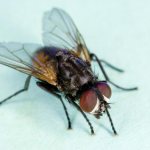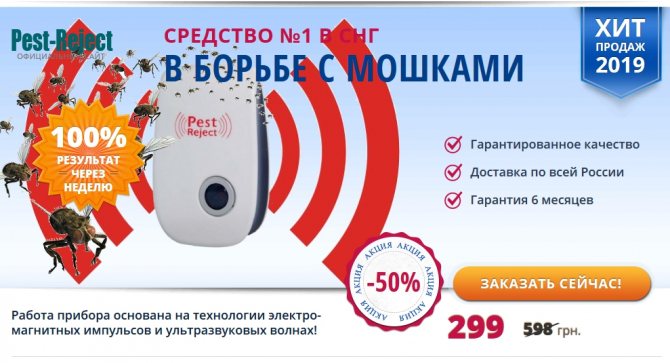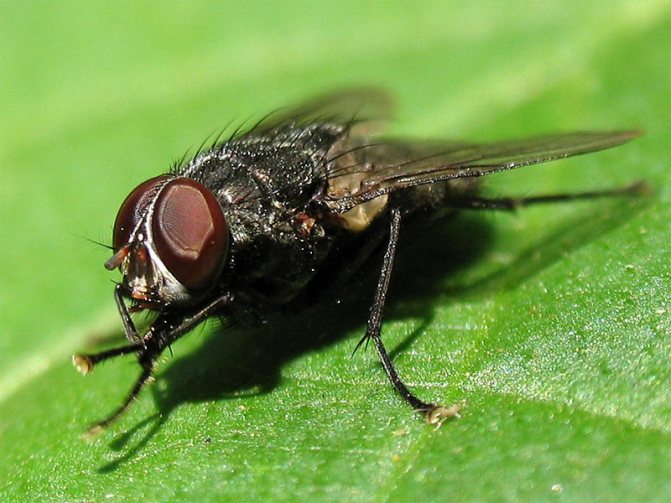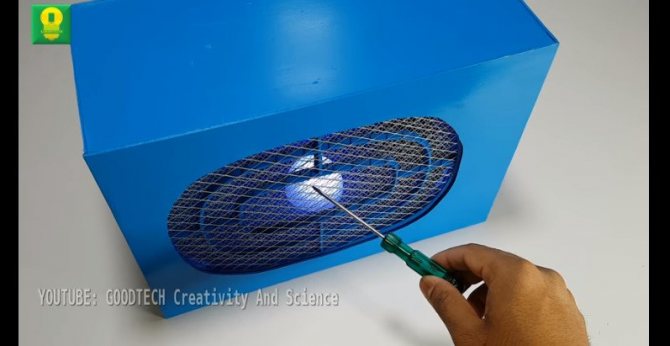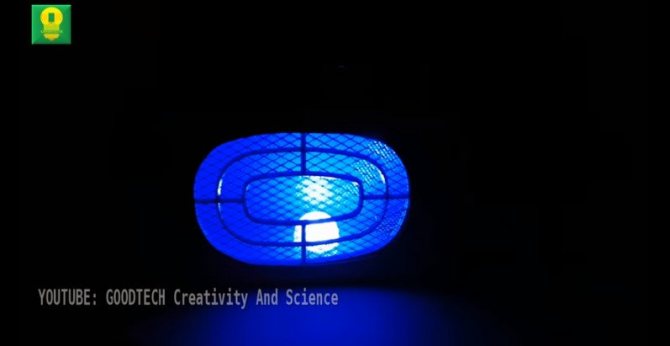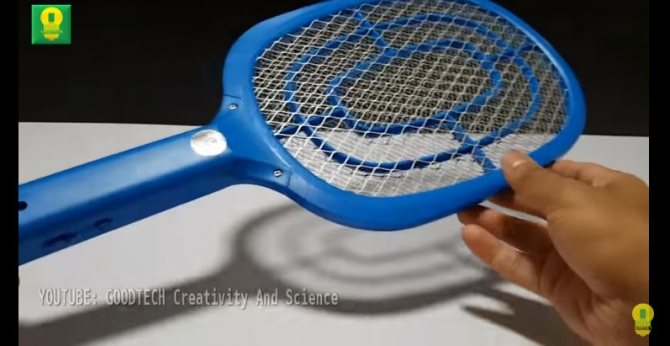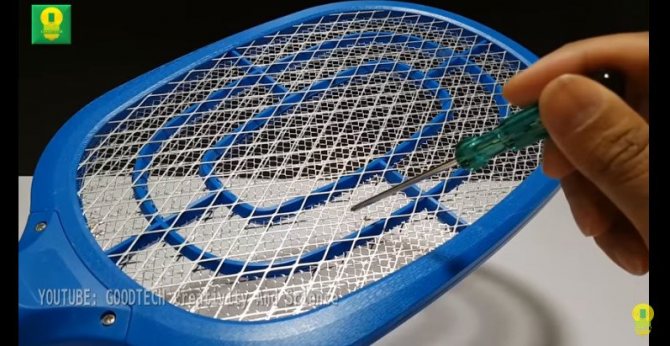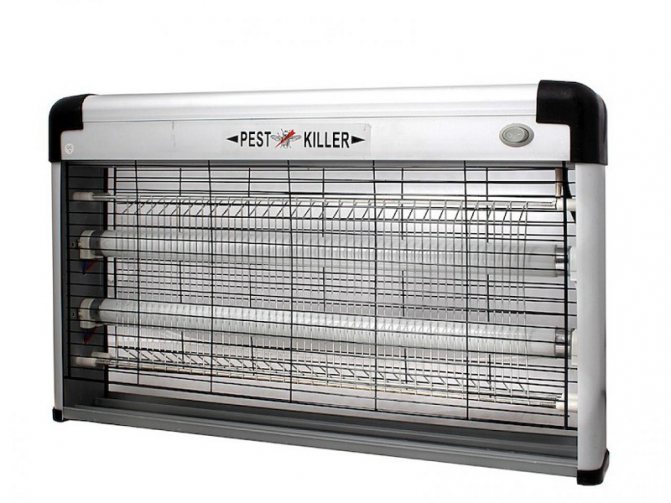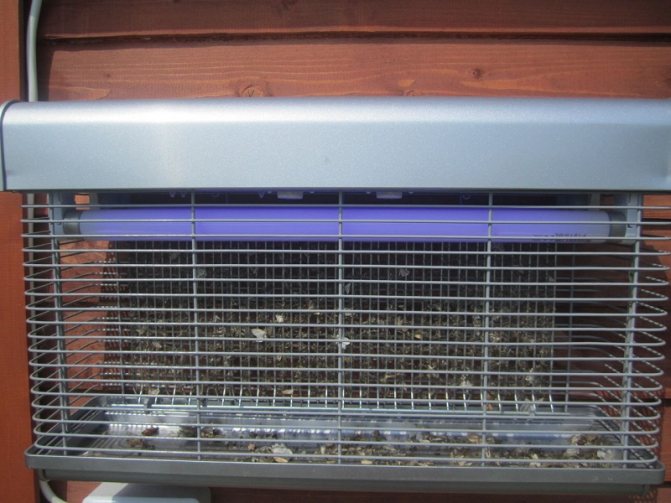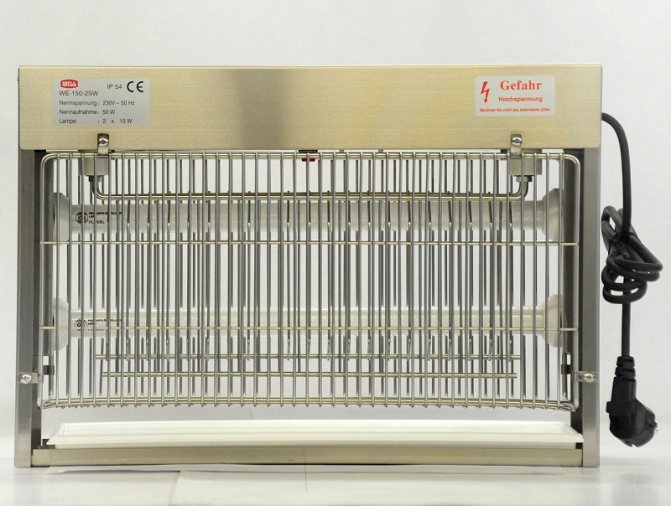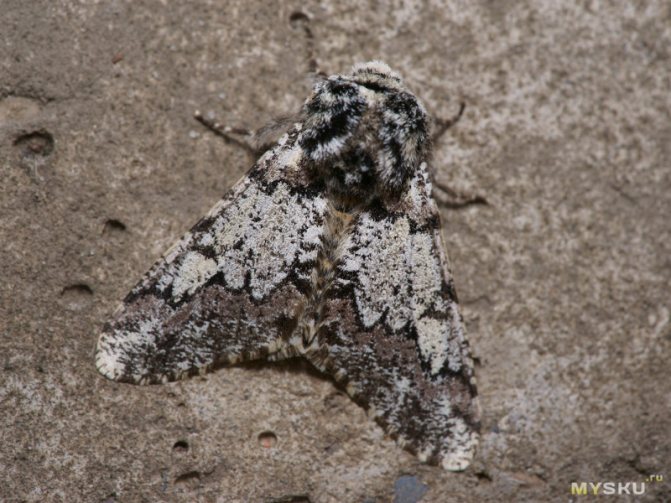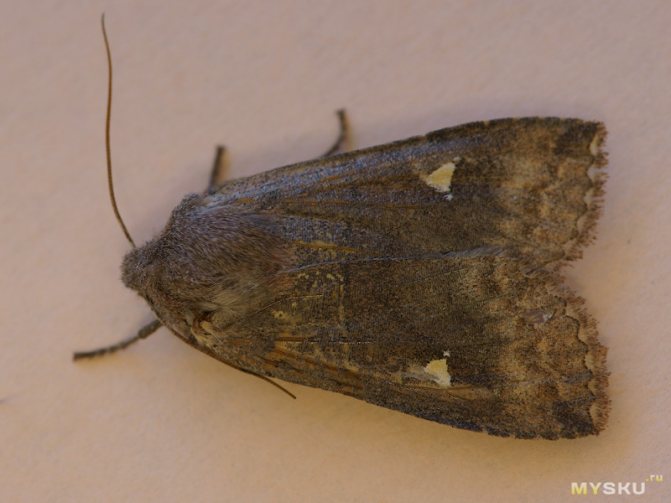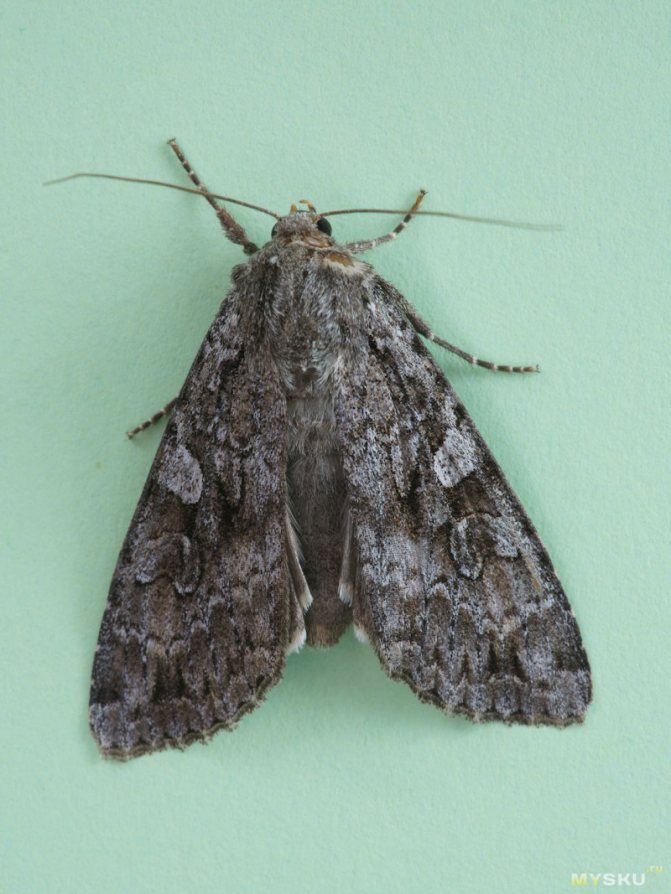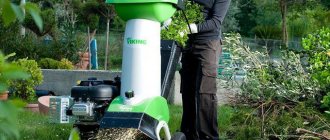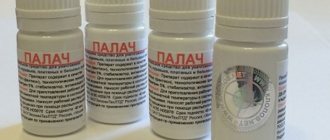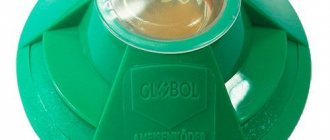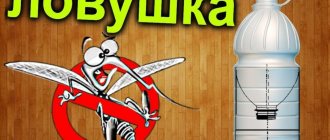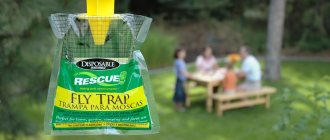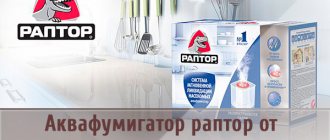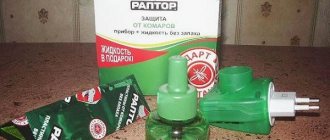Interesting about flies
Readers now know how to make a fly and wasp trap. Surely, many are also interested in what goals the insect pursues. If bees live to make honey, then flies and wasps pursue completely different goals. They try to lay as many eggs as possible. One fly manages to reproduce up to 2000 larvae. Moreover, they live only a couple of months, and sometimes up to two weeks. For one clutch, the fly lays about 120 eggs.

A cesspool and even soil in a flower pot are most suitable for this. The fly will appear in a couple of weeks. Moreover, the warmer the ambient temperature, the faster the larva matures. Flies sleep in winter. An active life begins only when the total daily temperature is +20 degrees. There is another interesting fact. Surely many are interested not only in how to make a trap at home, but also in why flies are always sitting on the windows. They just have compound eyes, because they simply do not notice transparent objects.
Types of fly traps
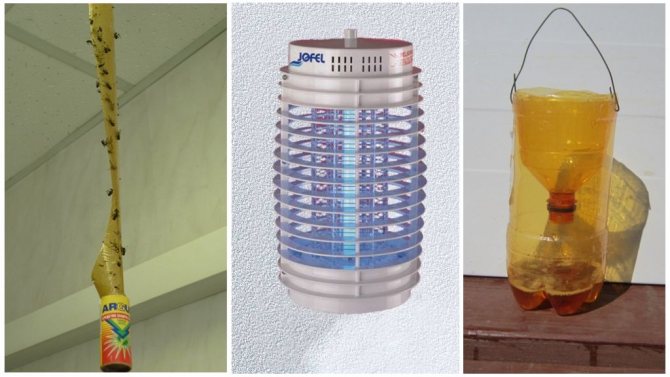

Types of fly traps
Unlike pesticides and synthetic insecticides based on Thiamethoxam (Agita, Aktara), safe traps can be used in close proximity to people, animals, without fear for their health. The main principle of such a trap is to attract the fly to the bait and prevent it from leaving the trap. There are three types of traps:
- Velcro - sheets of cardboard or tape covered with a sticky mixture that has a pleasant sweetish smell. Flies land on such baits and stick. Advantages of adhesive tape: easy to make and cheap to buy in a store, convenient to use anywhere, easy to clean up and dispose of along with stuck insects. The disadvantages include the unpleasant appearance of hanging traps in the room, the risk of hitting the head with a sticky bait suspended from the ceiling.
- Trap traps with bait are made from improvised means. Insects fly into a certain compartment with a bait, but cannot fly back. Jam, honey, sweet water, pieces of fruit or meat can be used as bait. The advantages of this method of catching flies are the ease of manufacturing the product and its effectiveness. The disadvantages of homemade products include the unpleasant smell of spoiled products that play the role of bait for flies, and the likelihood of the container being overturned by curious pets or a child.
- Electrofumigators. Devices requiring consumables in the form of an insecticide in a bottle or from a special plate with a poisonous substance. Plus: they work without misfires. Minus: depending on the composition of the insecticide, it is sometimes necessary to ventilate the room after use.
- Electric fly traps are special devices that run on electricity. They attract insects with ultraviolet glow and heat, but when flies come into contact with a certain surface, they kill them with a discharge of current. Such a blow is not capable of injuring a person, but for small flying insects it is fatal. Other electronic traps work differently - they suck in closely flying insects. The advantages of an electric trap are a stylish appearance, an additional light source in the dark, high efficiency, and safety for others.The disadvantages include the high price of electric fly exterminators, power consumption, and bulky devices.
- ... When connected to the network, they emit a sound inaudible to the human ear, which should make the flies stay away. Cons: does not always work; pets hearing ultrasound may be against it.
Water bag as a fly repellant
It is believed that flies dislike mirrored surfaces that reflect sunlight. Therefore, as some housewives advise, you need to do the following:
- Choosing a whole plastic bag.
- We fill it with water.
- We throw shiny brand new coins into the water.
- We hang the package near a window or balcony.
The method, frankly speaking, is dubious. This way you can scare off sparrows and other small birds, but not insects. As for mirror surfaces, a reasonable question also arises: if flies hate them, why do we clean the mirrors from traces of flies in the summer, almost every day?


In this way, they try to scare away flies in Asia.
I wonder if the way actually works? Here's what people who have tried such a repeller say:
I tested this method, I did not notice any effect. Flies both flew and fly, land on these packages and do not show any signs of wild horror at the sight of them.
jar-ohty [76.1K]
Just imagine. A fly flies, flies into the apartment. Ordinary apartment, ordinary furnishings. Only packages hang around (for no reason, no reason!), And in them (who would have thought!) - water, and in it (in general!) - coins. The fly thinks about it. Surely, psychos live in the apartment. It is necessary, the fly decides, to stay away from here. You can expect everything from psychos.
Mikhail Belodedov
The Mythbusters in Season 10 (Episode 157) refuted the myth that a hanging transparent bag of water repels flies. They conducted a test, it turned out that the package, on the contrary, attracts!
Ksusja
Ultrasonic and magnetic repellents
The ultrasonic trap differs in that its principle of operation is not to destroy mosquitoes and cockroaches, but to scare them away. The device is inserted into an outlet and begins to spread ultrasonic waves around itself (or creates powerful electromagnetic fields), which blood-sucking do not really like. They are forced to flee.
Advice
Be careful when choosing a device of this kind, avoid fakes. For the best effect, use the device with the longest range. Remember, scarers will only drive away annoying creatures to your neighbors for a while, but then they can always return.


Terms of use
Instructions for use are attached to each device. To maintain the device's performance, it is recommended to follow all operating rules. Do not allow moisture to enter the lamp, as well as mechanical influences in the form of shocks and falls. In the event of a power cable malfunction, immediately disconnect the device from the mains and contact the repair service. In no case should you resort to repair yourself.
During the especially popular seasons for mosquitoes and flies - the warm season - it is recommended to take more careful care of the mosquito lamp. The appliance needs to be cleaned more often so as not to reduce the efficiency.
Attention! It is best to place the lamp against flies, midges, mosquitoes and moths in the areas where insects spend the most time. These include windows and doors that allow pests to enter the premises.
Popular traps
The electronic mosquito trap is an indispensable tool during the high season of parasite activity. It allows you to protect a person from bites of bloodsuckers on the street and indoors.
Electric shredder SWI-20
Made in Switzerland, the device effectively controls mosquitoes in an area of up to 250 square meters. m, if connected to a 220-240 V power grid.The device is allowed to be used indoors and outdoors, provided that the trap is protected from atmospheric precipitation.
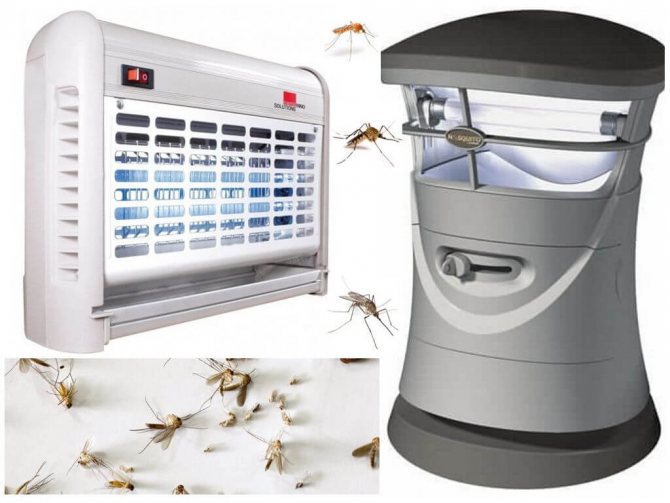

Electric Shredder SWI-20 and Stinger Indoor Insect Trap
On a note!
The manufacturer has provided various options for installing the device - it can be fixed on a wall, ceiling, or simply placed on the floor.
The mosquito killer SITITEK Sadovy-M works in a similar way.
Stinger Indoor Insect Trap
This eco-friendly device is equipped with a replaceable UV lamp and a fan. The pull-out container is easy to clean from dehydrated mosquitoes. This procedure must be performed at least once a month. The price of an effective device is within 2 thousand rubles.
Dinatrap photocatalytic trap
Branded products are the leader in sales. This is due to the safety of the structures, since there is no gas cylinder in them. Carbon dioxide, attractive to mosquitoes, is released as a result of a chemical reaction - exposure to ultraviolet light on a trap covered with titanium dioxide. An insignificant amount of emitted gas cannot harm a person, but this amount is quite enough for insects.
Users prefer Dinatrap DT2000XL Insect Trap, 1-Acre. The trap is not very expensive (about 10 thousand rubles) in comparison with analogues. It can be used indoors and outdoors. In addition to mosquitoes, the device is designed to destroy bedbugs, wasps, hornets and other parasites.
The manufacturer supplied the device with a 2-meter cord for connecting to the mains. To enhance the effect, the gas bait is equipped with a UV light and a fan. When the power is turned off, the trap slams shut and the mosquitoes and other insects trapped in it cannot get out.
Feedback
The device became our salvation, even though we initially wanted to purchase the Mosquito KRN-5000 Turbo PRO unit, we were confused by the prospect of changing gas cylinders. We use it on a large territory of a mini-farm. The trap performs its task perfectly. It has to be cleaned every two weeks due to the abundance of mosquitoes and other pests. A good adaptation, and most importantly - safe for both people and animals. Recomend for everybody.
Vladimir, Ryazan
Pestkiller Mosquito Trap
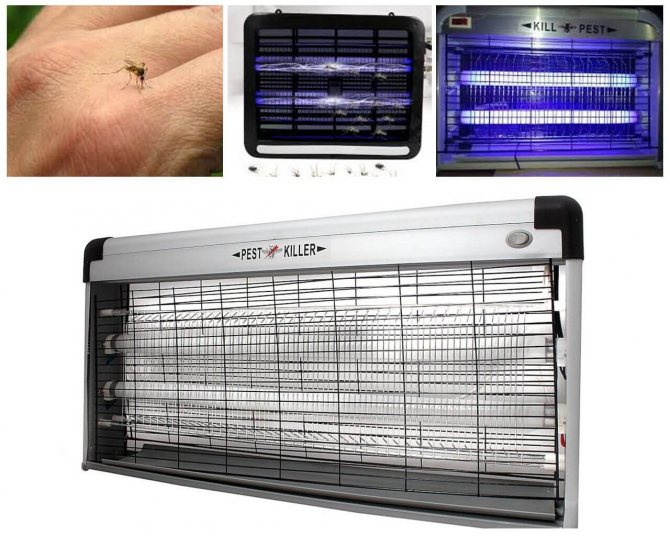

Pestkiller Mosquito Trap
There is a special fastening ring in the upper part of the body. The mosquito trap is equipped with a chain that allows you to hang it in a place convenient for the owner, which significantly increases the efficiency of the device. The range of the device reaches 40 square meters. m.
Varieties of devices
Commercially manufactured devices for killing mosquitoes and other harmful insects work on the same principle. They lure the parasites into the space from which they are no longer able to get out. Inside, the bloodsucker dies from electrical discharge, poison, or dehydration.
On a note!
Mosquitoes are attracted to the smell of the human body, light, heat and water. This is what lies at the basis of the action of various traps.
One or several mosquito "lures" can be used as bait in the devices. All of them are associated with food or reproduction in pests, so they tend to reach the trap.


Types of Insect Traps
- Devices with ultraviolet lamps. They attract insects with their light. Mosquitoes come into contact with a high-voltage metal plate and are killed by an electric shock. Traps are completely safe for humans and pets, as they do not emit any harmful odors and are aimed only at destroying blood-sucking insects. To enhance the effect, the devices use safe attractants that imitate the smell of the human body.Consumer reviews posted on the site confirm the high efficiency of innovative technology.
- Special devices with a fan installed inside, like a vacuum cleaner, suck in mosquitoes, flies and other insects approaching the trap. The device attracts with the light of a lamp and a small amount of carbon dioxide, which reminds insects of the smell of human skin.
- Carbon dioxide trap. The device is equipped with a lamp made using a special technology that emits carbon dioxide and simulates the heat emanating from all warm-blooded animals, including humans.
All devices work on the principle of emitting light, generating heat and carbon dioxide, due to which mosquitoes mistake traps for living organisms. Models are equipped with a fine-mesh metal mesh that allows an electric current that is destructive to insects to pass through.
How to make a device with your own hands
In order to build your own electrical device for flies, it is important to prepare:
- A filter that will interfere and act as a trap.
- Transformer. It is recommended to use a high voltage electricity transmitter.
- Regulator.
If you do not have a suitable transformer, you can use the secondary winding, which is located in an old TV (a black and white TV is also suitable). The advantage of using this winding is that it makes sounds during operation. This will help you determine the operability of the device, and change the incandescent lamp in time. During the construction of the device for the destruction of pests, it is important to correctly design and strengthen the filter that will serve as a trap. It blocks the waves of the receiver or TV.
To obtain a filter, cut out two circles or discs from a textolite plate, their diameter should not exceed 170 mm, and two discs with a diameter of 150 mm.
Fold the discs in pairs, and make 5 mm indentations around the perimeter of each disc. You should have a total of 36 indentations. On each disc (one hundred and twenty degrees apart), mark and punch holes. Their depth should be five millimeters. These holes will support the holders. Holders for structures that will help kill pests can be used in brass. Their length should not exceed 210 mm. The rod must contain a thread: at one end, a thread diameter of 30 mm, at the other end, a thread diameter of 50 mm.
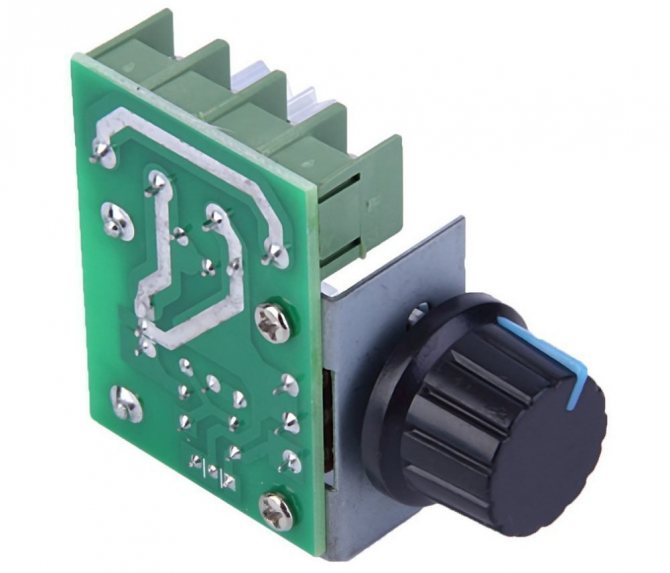

Voltage regulator - a must
Assembling the structure
It is possible to destroy pests with an electric device without the use of chemicals thanks to a properly assembled structure. Fold the prepared discs. It is important that the smaller discs are in the middle and the larger discs are at the edges. The holder must be installed between the discs, so that the threads of the two ends enter the grooves on the discs. The recommended distance between the discs is 15 mm, the discs should not be located in one line. The disc into which you screwed one end of the rod will act as the bottom of the device, which will help kill flies. If you have correctly assembled the base of the device, then the upper discs can be removed.
To eliminate insects, it is important to correctly position the lamp. It is recommended to install the socket so that in the future it would be easy to change the lamp without disassembling the structure and removing the mesh.
The mesh is recommended to be made of copper wire with a diameter of 0.5 mm. The wire is installed along the discs. Both ends (small and large disc) are connected to a transformer. You can place the structure in a plastic container. The device for the destruction of pests, moths and other insects is ready.
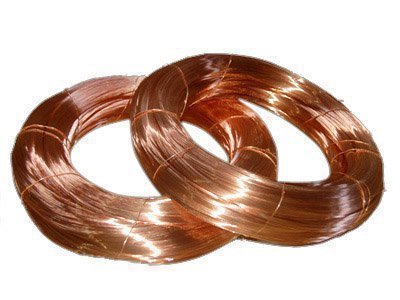

Copper wire is ideal for mesh fabrication
DIY hunting belt - photo
Now the very procedure for making trapping belts with your own hands.
one.At a height of about 20-40 cm, we wrap the trunk with several layers of film. It is cling film that is offered, and not any other material. Firstly, it is very flexible, stretches well and will not squeeze the bark - this is important for young trees that grow quite intensively.
Secondly, the smooth surface of the film makes it difficult for aphids to be transported by ants.
2. Cut from fabric strips 2-3 cm wide and long enough to make two or three turns around the trunk. We moisten the strip abundantly with grease and tie it over the film approximately in the middle -
It is better to hang the moth bait a week earlier than two days later not. If the tree has a smooth bark, then that's enough.
In the case when the trapping belt is placed on a tree with a large bark roughness, one more operation should be performed. Before wrapping the trunk with a film, it is necessary to putty the irregularities of the bark with ordinary clay, otherwise the ants will pass through the cracks, like through tunnels, along the trunk under the film. Check the condition of the coating periodically and renew as it dries.
Sometimes ants make "bridges" from the bodies to overcome obstacles, so from time to time you should carefully look at the zones of the trapping belts. Often a tree or bush in contact with the crown is used to avoid an obstacle. Even tall grass can serve as a back door to your tree. Having found ants on the branches, carefully trace the entire route of their movement and take the necessary preventive measures.
A good effect will be the simultaneous attraction of entomophagous insects to your garden. But this is a topic for a separate article. Happy hunting!
Is it mandatory to use industrial traps for the HACCP HACCP system
There is an international system HAASP (in the English interpretation of the abbreviation - "HACCP"), which ensures the organization of food safety, management and control of all production processes. Workers in kitchens or workshops where food products are developed must undergo training under such a program.
After installation, the workshop must be constantly monitored and the traps must be cleaned by an employee whose job responsibilities include monitoring the cleanliness of the room, including from flies, mosquitoes, moths, wasps and other insects that can transmit infections to food ingredients and products. Therefore, the installation of insect traps is mandatory here according to the HAASP standard!
Commercial insect traps are often used privately in the following situations:
- when there is a high probability of numerous accumulations of dangerous insects - for example, if people live close to bodies of water, from where many mosquitoes regularly arrive;
- if someone keeps a subsidiary farm, such a trap may turn out to be a salvation from flies in a pigsty, or in a cowshed or poultry house;
- for those who keep a garden or vegetable garden, a greenhouse and store vegetables and fruits - traps save from a large accumulation of wasps, bees, flies.
In any other cases, when people go to the dacha, to a country house, they have an estate - such insect catchers that can be installed even on the street can always come in handy.
An example of use in a rabbitry video
Types of traps
The classification of such devices is carried out according to the principle of their operation today, in accordance with this criterion, the following varieties can be distinguished:
- Glue traps are one of the most well-known and common varieties, their popularity is due to their simplicity of design, which makes them easy to operate and low cost. You can use houses or adhesive tapes that stick to any surface. This type of device has a double effect, since it allows you to catch both flying and crawling insects.However, it is recommended to use hanging adhesive tapes directly to kill flies. Despite the fact that crawling insects cannot get caught in such traps, they will be one of the most effective means against flies.
- Devices containing baits poisoned with various types of insecticides. They are considered traps only formally, since in fact they are not intended for catching flies, but to attract their attention with food bait in order to cause poisoning and subsequent death. Usually used to kill cockroaches or ants, fly control devices are not so widespread, since other options are much more effective.
- Mechanical traps with various baits designed to collect trapped insects. Attachments of this type are used to catch virtually all types of insects and flies, in this case, are no exception. There are various options, but they all function according to a similar principle: flies get inside a special container, attracted by the bait, but they can no longer get out on their own.
- Electric traps are the most innovative way of fighting, there are models designed to kill various types of insects. To attract mosquitoes and butterflies, special lamps are usually used, to the light of which they fly, but for flies, devices with a fragrant bait are suitable, which will attract them with its scent. After getting inside the trap, the insect will receive an electrical discharge that is fatal to insects, while it is not capable of causing any harm to humans or pets. Electric models are the most expensive, but they are also designed for long-term use, since the traps only need to be cleaned from time to time to remove dead insects, after which they will be ready for use again. Today, two types of electrical devices are distinguished: those that function after being connected to a home electrical network, or that operate on replaceable batteries. The second option is usually used for catching flies outdoors.
Instructions for use, safety issue
The current flows through a metal grid located inside the trap behind a plastic structure. When used correctly, the likelihood of being electrocuted is minimized. Even if this happens, the person will feel a slight tingling sensation, numbness of the limb. Everything goes without serious consequences.
It is necessary to install a desktop trap in the form of a night light at a distance of 5 m from a person; suspended, wall-mounted are fixed according to the instructions. Periodically, the trap needs to be cleaned of dead insects. Beforehand, the device is disconnected from the electrical network, the tray is removed, wiped out, put in place, the device is connected.
There is a risk of electric shock when:
- incorrect placement of the trap;
- moisture ingress;
- excessive curiosity on the part of young children.
Important!
If there are kids in the house, the insect trap is hung from the ceiling in an inaccessible place, and the child is not left unattended.
Electric insect killers
For people who do not have time to make homemade products, but want to quickly and effectively get rid of the flying gnat, there are electric fly traps. These devices are made of a metal case with a fireproof plastic coating, and have several UV lamps, the bright light of which attracts insects. On the way to the lamps, the flies fall on the grid, through which the current flows, and immediately die. The conductive element is protected by an additional coarse mesh to prevent accidental contact with a person or pet. Such devices also help to get rid of mosquitoes and midges.
Pest killer
Electric device for the extermination of flying insects.Two 20W ultraviolet lamps act as bait. A metal mesh that conducts current passes near the lamps. The trap is designed for flies and mosquitoes. For the correct functioning of the device it is necessary:
- set the trap on a flat surface;
- connect to the AC mains;
- make sure that moisture does not get on the device;
- periodically clean the dead insect tray.
The price of the device is about 3500 rubles. The device is durable and, if used correctly, will last for several years. The radius of the trap is up to 120 m2. Power consumption 15 W. Overall dimensions: 51x31.5x10.5 cm; weight 2.3 kg.
Electric insect killers
Well
Industrial electric traps are widely used in shops, warehouses, markets against flies, mosquitoes and other insects. The device is mounted on a wall at a height of 2 meters above the floor. The product includes ultraviolet lamps, the light of which attracts insects to itself. Flying close to the lamp, they fall on the conductive grid and die.
The main parameters of the Well electric trap:
- area of action up to 50 sq. m .;
- weight 3.3 kg;
- dimensions: 34x28x13;
- lamp power 8 W;
- body material - plastic;
- power consumption - 25 W;
- the price is 6800 rubles.
Radius of action
An insect catcher for the house is made in the form of nightlights, the spectrum of influence is limited to one room. If you need to protect the whole house, buy several pieces. Placed on a bedside table, tables, hung on a wall, attached to the ceiling. It starts working immediately after switching on, the effect becomes noticeable after 20-30 minutes.
Outdoor flying insect traps are made more powerful. The radius of action covers 5-50 m. It is installed on a hard surface or suspended, the leg is driven into the ground. Devices are very often made in the form of a lamp, a lantern.
On a note!
Universal electrical traps can be solar powered. They recharge during the day, work at night, there are no operating costs, except for the funds to buy the lamp itself.
What is the equipment
Some manufacturers, in the manufacture of such equipment, specialize exclusively in metal devices that look like a heater, a heater, powered by the mains. Other manufacturers prefer to produce such devices in a wider range - with plastic or metal (stainless steel) cases.
The built-in UV lamp attracts insects; when the device is switched on, the metal grill is always under an electric current, which strikes the insect that has settled on the grill. A special tray is used to collect dead insects. The cases are equipped with special protrusions that protect the person from accidental contact with the grill of the device.
Device characteristics
When the device is connected to the network, a lamp lights up, from which heat and a spectrum of ultraviolet rays emanate. This is where the trap begins its work, flying insects are attracted by luminous heat, which is why they fly directly to the lamp. The spectrum of radiation for a person is not dangerous, even if he is constantly in the room with a working device. In addition, the mesh casing of the device protects against direct contact with the high-voltage grid. Unlike humans, for insects, he is not an obstacle.
Trap bait
A suitable bait will be a light bulb with a bayonet base, as well as a holder for it. The surrounding air will heat up and illuminate the space at the same time. Everyone knows that light is the main bait for insects. Instead of a light bulb, you can use LEDs. Moreover, it is more economical to buy them in the tape, and not separately. In addition to light, you will need another bait. Komarov will be interested in obtaining which you will need to dilute the same amount of sugar and 5 g of yeast in 0.5 cups of water.The bait should be added to the container to be attached to the body of the trap.
These are the easy but effective methods for dealing with flying insects. They are much safer than aerosols and other chemicals. Therefore, it is better to spend some time making your own trap than spending money on other methods of fighting insects.
Pheromone trap
Insect females, during the breeding period specified for them by nature, secrete a substance with pheromones that attracts males. Males can smell this substance, causing them the instinct to mate, several kilometers away. An insect trap using an artificially produced pheromone perfume is, by its principle, simple to the point of impossibility. The design is based on the use of adhesive tape, in the middle of which a fragrance is applied. Striving for an alluring smell, insects, having stepped on the tape, remain on it, not having the ability and strength to tear themselves from its sticky base.
Based on the above, we can conclude that today, insect traps are very diverse and very effective.
The principle of operation of devices
Industrial traps, which perform insecticidal functions, are special structures that can destroy insects that have fallen to them according to the principle:
- electric shock - the insect dies from a high voltage discharge of an electric current;
- glue trap - the insect sticks to the tenacious glue composition on special trap plates and remains there to die;
- drawing in (suction) by a fan into a sealed container.
The mechanism of action of such devices is as follows - insects fly to it, attracted by the light of the lamp, then are destroyed from the resulting discharge by current, either they are glued to the adhesive base of a special plate, or are drawn by a fan inside the trap, into a special container. The last version of the mechanism of the installation is more related to cylindrical traps.
There are also electrical industrial traps, which are intended for different places of use:
- plastic traps with a sealed base are most often used for outdoor use;
- metal with gratings - for large-scale premises with a large area;
- and stainless steel options are great for cases where intensive work of the trap in a large room is required, as well as a long service life.
The choice of a trap depends on what tasks are required to be solved and what sanitary and hygienic requirements are set by municipal government bodies for a particular enterprise. For example, if in tea production it is necessary to ferment tea raw materials outdoors under the sun or under a canopy in a ventilated pavilion, then it would be most appropriate to use insect traps designed to work outside, and not indoors.
Examples of ALT traps
Range of application
An electric insect catcher is made for indoor and outdoor use. Devices differ in range, power, design. There are insect traps with moisture protection - visors, covers, other additions to the main structure. The latter are used on the street: in yards, gazebos, on summer grounds of shops, restaurants, recreation centers.


Electric Insect Traps
Externally, street electronic traps resemble a flashlight or heater. For the premises, the devices are made more original. They combine several functions at once - a night light, an insect catcher, a compass, a clock, etc. The design is very different, they are placed on a solid surface in any convenient place, suspended from the ceiling, and attached to the wall.
On a note!
The ultraviolet trap can operate from a city power supply network, a storage battery. The latter option is often taken with them on vacation.Set up in a tent, near the gathering place.
Insect glue trap
Glue types of traps are among the safest and most effective inventions, which are also very affordable. The general principle of the device is based on the use of a sticky, but fragrantly attractive bait for insects, which is applied from the inside to the bottom of a small cardboard house. Insects follow the smell, make their way inside the box, from where they can no longer get out, since their paws reliably adhere to the sticky glue bottom.


It is necessary to set glue traps for insects in the places of the most active movements of these uninvited guests, and such areas can be easily calculated by the visible traces of their vital activity. Despite the fact that such an adhesive application does not dry out for quite a long time, nevertheless, the houses have to be changed often because of the insects that have accumulated in them. Therefore, stopping your choice on them, it is better to acquire several such trap houses at once.
Electric Flying Insect Trap
Electronic traps are based on the use of an ultraviolet lamp. Placed inside the body, with its light, it attracts all kinds of flying midges, which instinctively flies to the light. But the path to the luminous source is blocked by a thin high-voltage grid, in contact with which the insect dies and falls into a special tray installed at the bottom of the device.
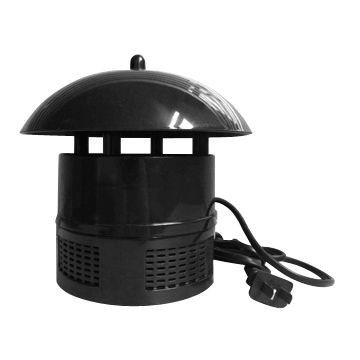

reference Information
DocumentsLawsNotificationsDocumentsAcceptancesActionsRequests for proposalsTerms of referenceDevelopment plansDocument scienceAnalyticsEventsContestsTotalsAdministrations of citiesOrdersContractsWork performanceProtocols of consideration of applicationsAuctionProjectsProtocolsBudgetary organizationsMunicipalitiesProgramsRegionsReports
by mentions Document base Securities
The provisions
Financial documents
Resolutions
Rubricator by topicFinanceCities of the Russian Federationregionsby exact dates
Terms
Scientific terminology Financial Economic
Time
Dates 2015 2016 Documents in the financial sector
Homemade traps
When making a do-it-yourself insect trap, the property of carbon dioxide is used to attract bloodsucking.
To catch mosquitoes you will need:
- plastic bottle;
- yeast;
- water;
- sugar;
- thick paper or dark colored cardboard.
The bottle must be cut in half. Turn the upper part upside down and insert into the lower one. Before that, you need to put in the bottom of the bottle the liquid formed from mixing water, sugar and yeast. Wrap all this simple device in paper and fix it tightly, for example, with tape. Place in a dark place. The liquid will begin to ferment, releasing carbon dioxide, which will lure mosquitoes. Once caught in a sweet sticky trap, they can no longer get out.


The simplest light traps for flying insects
Since all winged individuals love light, they can be caught by attracting them with the light of a lamp. Pull a white sheet on two sticks, and place a bright lamp behind it. When night guests come to the light, they will bury themselves in an obstacle in the form of a sheet. It remains only to collect them in a container intended for this.
You can install the lamp over a cloth. Insects that have flown into the light will crash into the lamp and fall dead on a piece of cloth spread on the ground. These light traps are simple and convenient.
You can also catch insects on a brightly lit window; it should be open and covered with light-colored cloth. All that remains is to wait for the insects that get stuck on the matter and collect them.
Advice
It is advisable to do all this at night, when the light from the lamp is seen more clearly and brightly.


Review of the entomological lantern C2. We attract moths to a photo session.
Summer is over, Siberia is covered in autumn, which means that the time has come to present to the attention of the venerable public an overview of the most detailed and complete overview of a unique and exotic lantern, which you have probably never seen before. For this lantern was created with only one purpose: to attract moths with its light. I turned on this lantern every night throughout the summer, and based on the results of my experiments, I can confidently say that it really works and attracts a fair amount of nocturnal insects even within the city. Well, details about the C2 entomological lantern, its structure and features of use, as well as photographs of the very moths that were attracted with its help, you can find further in the review.
Usually, when it comes to butterflies, in our imagination there are images of daytime butterflies, bright or not very, large or smaller, but, in general, well-known to everyone. It is much less known that, despite all its diversity, daytime butterflies make up no more than 15% of all species of Lepidoptera, while the rest of more than one and a half hundred thousand species of butterflies belong to the kingdom of the night.
Why don't we see all these thousands and tens of thousands of butterflies? Because these moths, fireflies, moths, fingerflies, scoops and many, many others are mostly so small and inconspicuous that even if they catch our eye, we still do not pay attention to them. And also because in the daytime, when it would be easiest for us to see them, they rest, and they try to do it in secluded places: hiding in dense grass, spreading out on the underside of leaves, disguised on tree trunks.
Nevertheless, among the moths there are very photogenic species. First of all, these are all kinds of hawk moths, of which at least six species live in the south of the Krasnoyarsk Territory. These are large and well-fed butterflies with narrow wings, similar to small birds. Some even know how to hover over flowers in the air, launching their long proboscis in them. It is to the hawkers that we should be grateful for the sensational stories that regularly pop up in the press, as another local resident noticed a hummingbird over his favorite garden of cucumbers.
Wine hawk
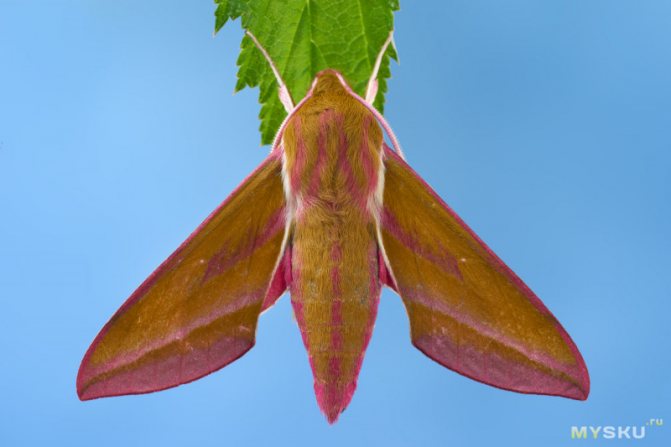

Blind hawk maker
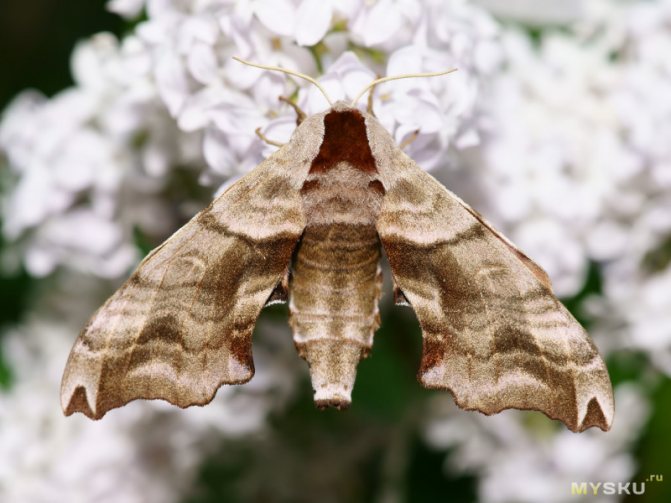

No less remarkable are scoops from the genus Catocala, better known to the general public as "order ribbons". These are medium and large butterflies, the front wings of which are covered with an unremarkable gray-on-gray pattern, but the back ones are decorated with bright "ribbons" of different colors. The most common sight is the blue ribbon, but I have seen butterflies with red and yellow ribbons on their hind wings.
Talking about large nocturnal butterflies, one cannot fail to mention the bear butterflies, many of which also lead a nocturnal or crepuscular lifestyle.
The she-bear is the mistress
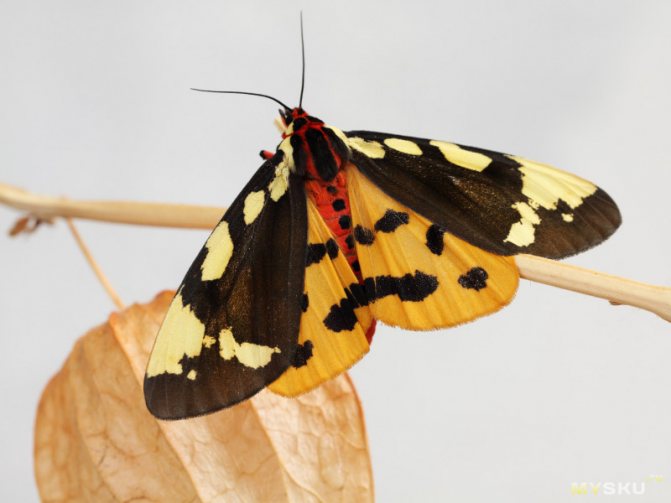

And, I repeat, all this was found and photographed by me in the Krasnoyarsk Territory, which is not rich in vivid representatives of the nocturnal entomofauna. Inhabitants of the Black Sea regions can enjoy an abundance of all kinds of hawk moths, peacock eyes and brahmas live in Primorye, and what flies at night in the forests of Southeast Asia invariably arouses admiration among macro-photo enthusiasts of the middle lane, mixed with a fair amount of burning envy.
"Cobrobutchka": a scythe from the Erebidae family. Thailand.


Hawk maker from thailand


Looking at all these pictures, you might think that they were taken during the day, or at least during the day. And this is really so: with a fair amount of luck, even the most nocturnal butterfly can be found on a sunny afternoon. However, the effectiveness of such a photo hunt is depressingly low: I managed to see no more than three of the same hawk moths per season, and the above bear is generally the only one for all eleven years that I have been doing macro photography.This state of affairs, of course, did not suit me, and over time I began to think about how to expand and deepen my acquaintance with the world of moths.
In the middle of the summer before last, in the middle of the night, I happened to pass the window of a beer boutique, illuminated by half a dozen bright lamps. Outside, the glass of the showcase was covered with an unimaginable number of different insects, among which I saw a rare large green moth and some other previously unseen, but cute, snow-white butterfly with a black speck. Contemplating all this abundance, I appreciated the photographic perspectives of the place. However, it didn’t smile at me to wander to the opposite end of the city and frap the drunken audience, taking off the fat, hairy moths from the window. Then I thought about a personal lantern that could lure moths to my loggia on summer evenings without attracting unnecessary attention.
Having rummaged through the Internet, I learned that insects are most attracted not so much by visible light as by ultraviolet radiation, and that entomologists use the widest range of means to attract moths, from car headlights, disco "black light" and "filling" tanning beds to a hellish device made of a high-pressure mercury lamp with a broken outer bulb. Around the same time, I accidentally found out about the existence of the Naturaliste online store, specializing in goods for entomologists, in which there was a "C1 entomological lamp", as it follows from the description, specifically designed to attract nocturnal insects. But somehow suddenly the summer ended, the butterflies flew away, and the purchase of a lantern lost its meaning for the next six months. By the spring, the lanterns disappeared from sale, and then I did not know how to make them myself.
In the middle of this winter, having discovered that almost the same “C2 entomological lantern” appeared on the virtual counter, I did not delay the purchase for the second time, and, waiting for the end of the Christmas holidays, I placed an order. Moreover, my plans for the beginning of spring included a trip to Vietnam, where I hoped to make a close acquaintance with the local Lepidoptera.
Lyssa zanpa, Urania family (Vietnam, Da Nang, Mount Ba Na)
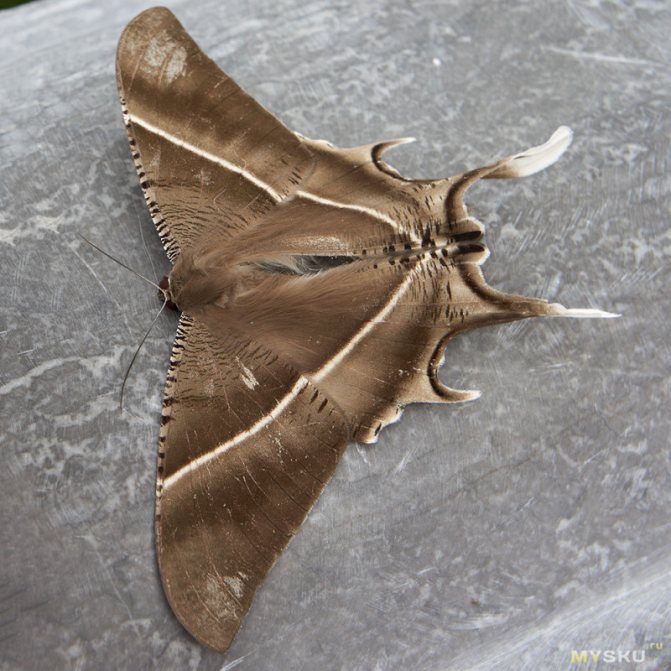

The store offered various options for delivery and payment, of which I chose delivery to the point of issue of orders in the regional center with cash payment on the spot. Delivery to Krasnoyarsk took two weeks; I was notified by SMS about the arrival of the flashlight at the pick-up point. A couple of days later, the package was in my hands.


What did I see when I cut the exotic orange tape and peeled off the onion layers of the bubble wrap? And I saw a box from an ordinary lamp on fluorescent lamps.


How so? However, I continued unpacking and opened the box. What was painted on the outside turned out to be inside too. My bewilderment grew: did they send me a simple rechargeable lamp?


But no, after a short reading of the attached instructions, I plugged the flashlight into the mains, pressed the red button, and the lamps flashed purple. Now everything fell into place.
Despite the presence of the word "lantern" in the title, this is not a lighting device at all. Although once it undoubtedly was: the inscription on the box says that in a past life this unit bore the name "LBA 3923A" and was intended to be used as a portable or emergency light source, because when the electricity was turned off, it automatically went into autonomous mode powered by battery.
The battery was the main disappointment. First, it turned out to be lead-acid, which put an end to the idea of taking it with you on a Vietnam voyage. Due to the baggage rules, which I was not too lazy to look into, lead-acid batteries are prohibited from carriage on passenger airlines, because of which an intimate acquaintance with tropical night butterflies had to be postponed indefinitely. Secondly, the battery turned out to be quite massive, and, at the same time, not very capacious: 4 ampere-hours at a voltage of 6 volts. After a full charge, the flashlight worked on the stored energy for a little more than two hours, which is absolutely not enough for autonomous photography.And thirdly, it is widely known that the capacity of lead-acid storage batteries during deep discharge significantly decreases, and several full charge-discharge cycles lead them to total decline.
The transformation of an ordinary flashlight into an entomological one occurred through the replacement of ordinary gas-discharge tubes of daylight with specialized Sylvania F8W T5 BL368. You can remove the lamps by unscrewing two screws and removing the protective glass, which I did by taking out one of them and taking a picture.


By visiting the website of the manufacturer of these lamps, we can find out that these are the so-called "black light lamps", the emission spectrum of which is mostly in near ultraviolet radiation, and their main field of application is light traps for flying insects. At the same time, the lamps are safe enough for domestic use and do not require special protection during use (however, the inscription on the tube warns that prolonged exposure of the eyes and skin from a short distance should still be avoided). There we can find out that the power of one such lamp is 8 watts, the operating voltage is 56 volts, the base is G5, and the length is 21 centimeters.
Here the attentive reader will have a natural question: what prevented me from assembling such a device on my own, having bought separately lamps and a lantern, and saving a certain amount of money on this? Now, knowing how it all works, I would probably do just that: I would find a flashlight with more suitable batteries and stick Osram lamps into it (there is an opinion that they are more "catchy"). However, at the time of purchase, my knowledge of attracting butterflies to the world was mostly theoretical in nature, which is why I began my journey in twilight entomology with the purchase of a finished product.
Having twisted the lantern in my hands this way and that, I discovered another drawback in it: it could not be simply hung on a carnation. Of course, there were wall-mount slots on the rear panel, but in my reality they turned out to be useless. I had to take up the electric drill, drill a couple of through holes in the body, smooth the edges of the holes with a file and thread the most ordinary rope through them, making a loop out of it. Despite the seeming unreliability of the solution, this loop has served well for more than three months and it is likely that more than one season will pass before the rope is frayed.
Otherwise, it turned out to be the most common rechargeable flashlight, despite the Russified stickers on the back cover, clearly of Chinese production.


It weighs a little more than two kilograms, the linear dimensions of the lantern are 405 × 75 × 80mm; The power cord, hidden in a special compartment of the case, is 1 meter long. In addition, the manufacturer declared protection level IP20 (protection against solid particles larger than 12mm, no protection against water) and compliance with GOST R IEC 60598-1-2003 and GOST R IEC 598-2-1-97, which is probably very important for industrial use. but is not of the slightest importance in amateur entomology.
On the side there is a kind of flashlight control panel, consisting of a red "TEST" button, a switch, three multi-colored LEDs and a socket with a 2A fuse.


The switch has three positions:
- The flashlight is off (the slider is in the middle position).
- The flashlight operates exclusively on battery power (the slider is on "Battery ON"). In this mode, the flashlight works only
if it is not connected to the network. - Mode "ON 230 V ~", in which the flashlight operates from the mains, if there is voltage in it, and from the battery, if there is no voltage in the mains.
The "TEST" button works only when the flashlight is plugged in and allows you to check the operation of the lamps. The purpose of the "Charge", "100%" and "20%" LEDs is quite obvious without additional explanations (which, nevertheless, are given in the instructions attached to the flashlight).
Having figured out the device of the flashlight and charged the battery, for the time being, I put it in the closet, since there is absolutely nothing to do with it in winter in Siberia. His time came in mid-May. When the snow, for the most part, melted and a stable positive night temperature was established, I decided that it was time to finally try the flashlight in action. I hung the flashlight on a Manfrotto 055 CLB tripod right in front of the mosquito net, and organized the power supply using a regular household extension cord.I watched the flying insects through a double-glazed window, so there was no need to worry about ultraviolet radiation: the window glass does not let it through. However, when there was a need to catch a butterfly for photographing or just to get a better look, I, just in case, still put on sunglasses. Of course, special goggles made of transparent plastic would fit better, but I was too lazy to worry about finding and buying them.
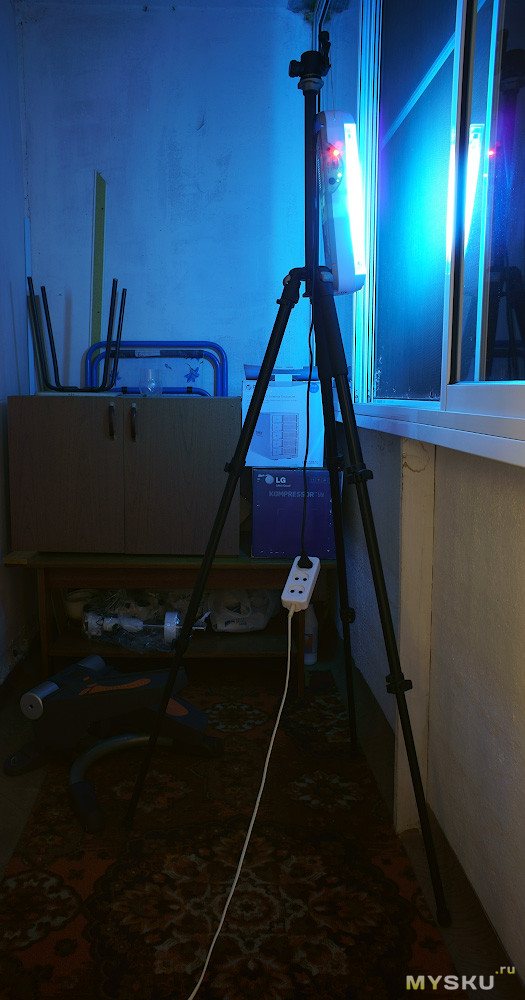

Preparation for a night photo hunt took no more than a couple of minutes, the same amount of time to fold and remove the equipment. The location of the lantern, however, could hardly be called successful: as it turned out later, a rare butterfly would fly to the loggia on the fourth floor. In addition, my humble flashlight had to compete with two powerful lamps illuminating the courtyard area.
The first activation was unsuccessful, at + 9 ° C insects fly at night, but very low. After waiting a couple more days, I tried again. This time the temperature was + 14 ° C and things went well: as many as four scoop butterflies arrived. Having decided that a start had been made, I began to light the lantern every evening, and the warmer it got outside, the richer and more diverse was the composition of the "guests" attracted by the lantern.
Insects attracted by the light on the mosquito net
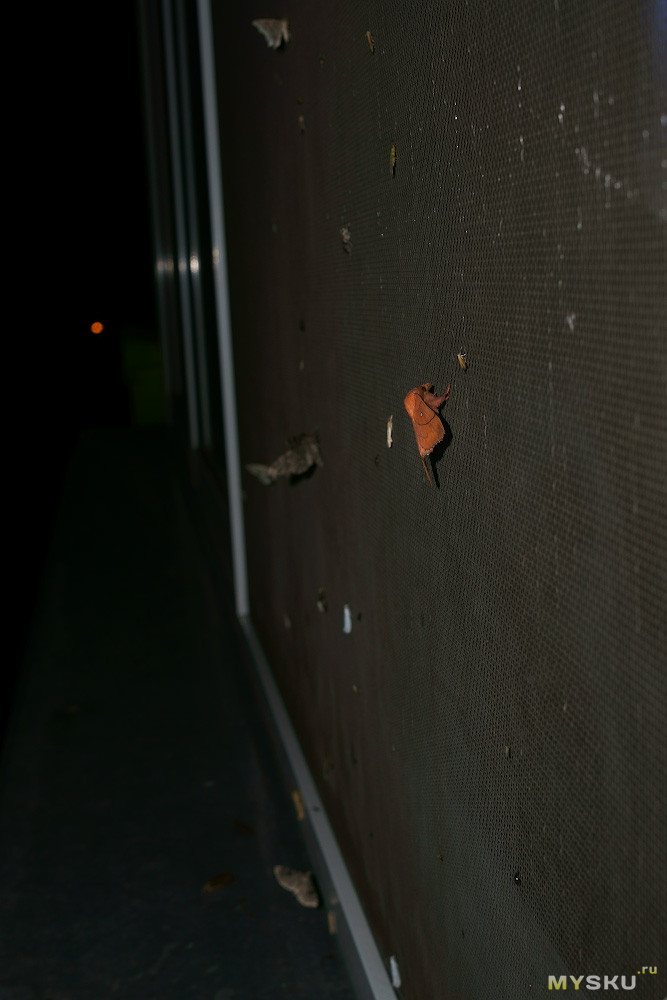

The most loyal fans of ultraviolet radiation turned out to be caddis flies, for they were among the first to fly to the light of a lantern. To the general public, caddisflies are known mainly for their larvae, which are highly prized as fishing bait. But adult insects flying along the banks of reservoirs before sunset are of little interest to anyone: outwardly resembling either a moth or winged ants, they are able to attract attention only with the annoying habit of getting into the eyes and getting caught in the hair. But besides those small and common caddisflies, the entomological lantern also attracts very large species that look, frankly, creepy.
Caddis flies
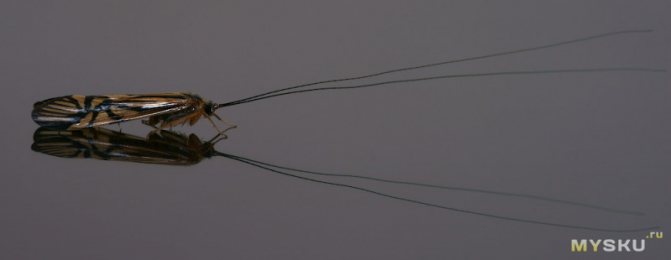

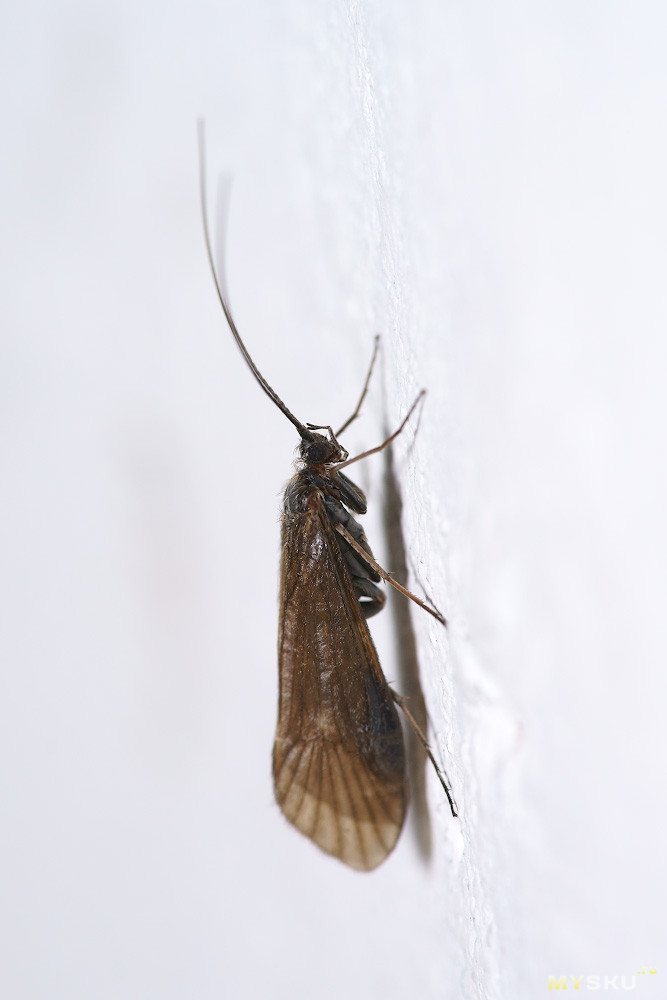

In reality, caddis flies - these distant ancestors of butterflies - are completely harmless, however, even among those who are aware of this, the first reaction to an approaching black something with webbed wings is to wave it off or apply something heavy.
Other common guests, especially those who covered the mosquito net at the beginning of summer, are mayflies. Despite some resemblance to giant mosquitoes, these creatures are not capable of causing harm to anyone. In principle, they are incapable of feeding, adults live from several hours to several days, and the only important event in their life is mating and oviposition, immediately after which they fall dead on the surface of reservoirs to the delight of the fish living in them. These creatures are most numerous in late May-June, but individual specimens arrived in the later summer months.
Mayfly
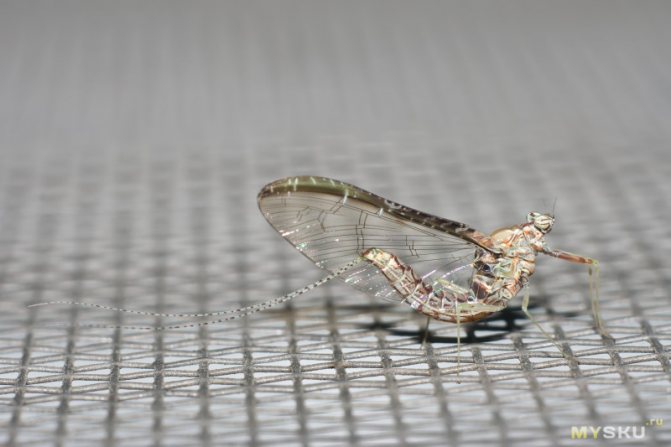

A little later, they were joined by the golden-eyed - pale green goats with mesh wings and small bronze eyeballs, well known to everyone who had a chance to walk in the evening on the wild grass that has never seen a lawn mower.
Lacewing
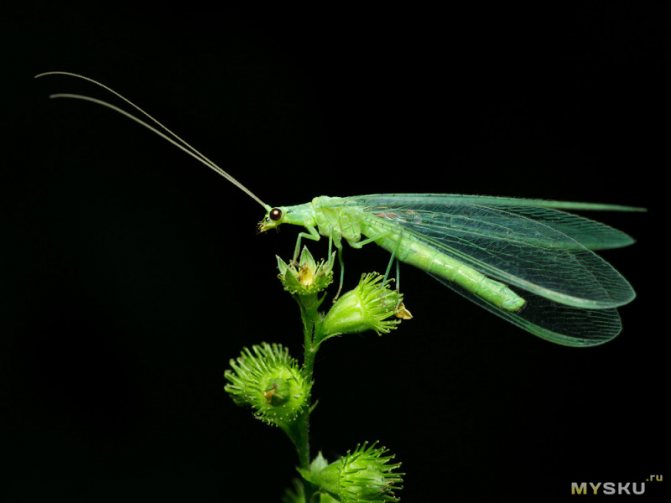

I was quite surprised by the ladybugs of various species, which fly to the lantern infrequently, but steadily throughout the summer. Moreover, not the well-known red-black seven-dot ladybugs were flying, but yellow and black varieties of these bugs. It is known that ladybugs are diurnal, and their regular appearance in the middle of the night came as a surprise to me. In general, beetles turned out to be the most interesting newcomers - of course, after butterflies. In the second decade of May, when on especially sunny days it is already possible to dress almost like summer, and the night temperature, though with difficulty, but exceeds + 7 ° C, the first May beetles appear. And they don't just appear, but begin to actively fly into the light.As you know, the May beetle is a large, heavy and clumsy creature, it flies a little better than an iron and gets to the fourth floor with great difficulty, so they rarely looked at my loggia and completely disappeared by the beginning of June.
Chafer
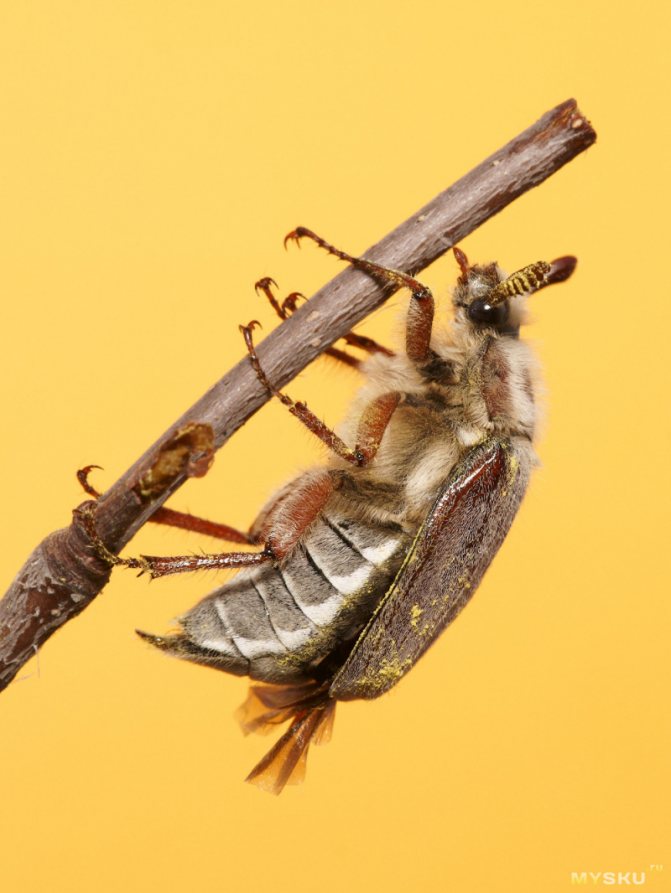

The unreliable and windy spring is replaced by a real, honest summer, and the May beetles are replaced by the June beetles, in the identifiers also passing under the name "June nonhrush". They are smaller, lighter, fluffier and more graceful, to ascend to a height of fifteen meters for them is not an achievement, but an everyday life. And so, in late June evenings, leaving the grassy jungle, they rush to the sources of bright light, without, of course, bypassing my invitingly burning lantern. These beetles fly violently, but not for long: a couple of weeks after the arrival of the first beetle, the main stream dried up, although the last, shabby and shabby June beetle caught my eye as early as on the second of August.
June beetle
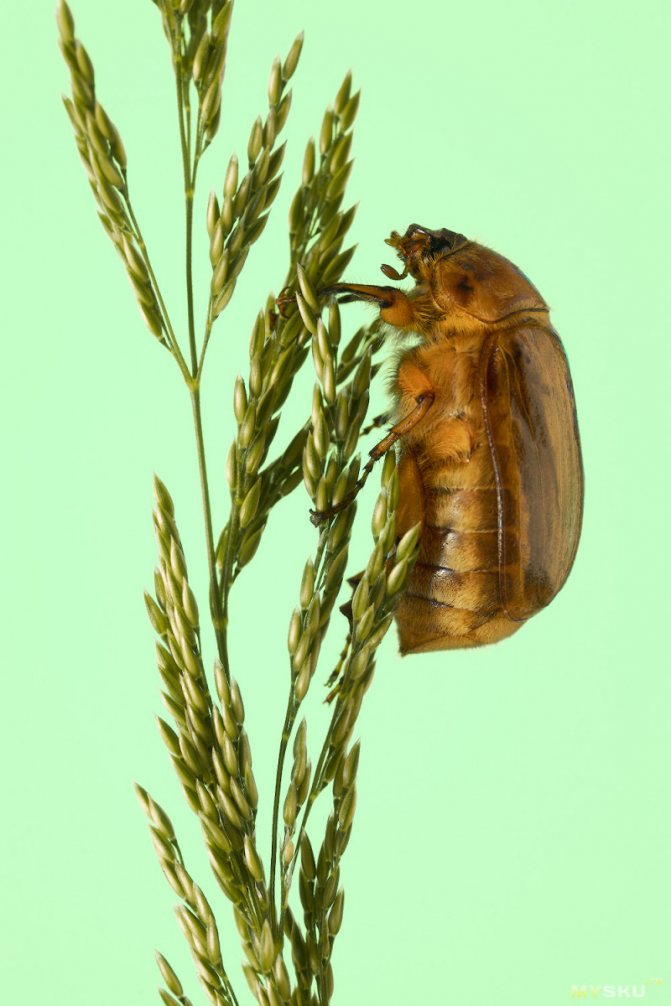

In early July, small longhorn beetles (whose larger brethren are popularly known as "striguns") got in the habit of flying to the lantern, and once even I found a swimming beetle on the windowsill. Despite its remarkable appearance, the beetle turned out to be so nervous and fussy that all attempts to capture it ended in complete fiasco. What he was looking for many kilometers from the nearest body of water is a mystery.
Other living creatures also flew in: scute bugs, annoying to the extreme parasitic wasps, it is not clear how they crawled through all the obstacles, flies, mosquitoes and "assorted" from all sorts of barely visible small fry that dotted the balcony with their withered corpses.
However, the most welcome guests were the very moths, for the sake of which everything was started. Most of all I wanted to attract the hawk moths (to whom I am not indifferent), large scoops - "order ribbons" and a large green moth. And, of course, I dreamed of looking at the famous "vampire butterfly" that appeared in the Siberian forests at the beginning of the 2000s.
From the very first successful switch-ons, butterflies-scoops were drawn to the lantern in discordant rows.
It is widely known that in many nocturnal animals, in the dark, the eyes glow with reflected light - some green and some red. However, it is much less known that the eyes of some moths, and in particular the most common scoop, in the evenings write cunning spirals around street lamps, have the same feature. Having received, thanks to the entomological lantern, the opportunity to observe in close proximity the most different types of scoops, I could not help but notice that the eyes of many of them, during the day, are dark brown or brown, in low light they acquire a noticeable red tint, as if half-extinguished coals were glowing in them. ...
In the following days, in addition to scoops, moths began to arrive, as the most common ones,
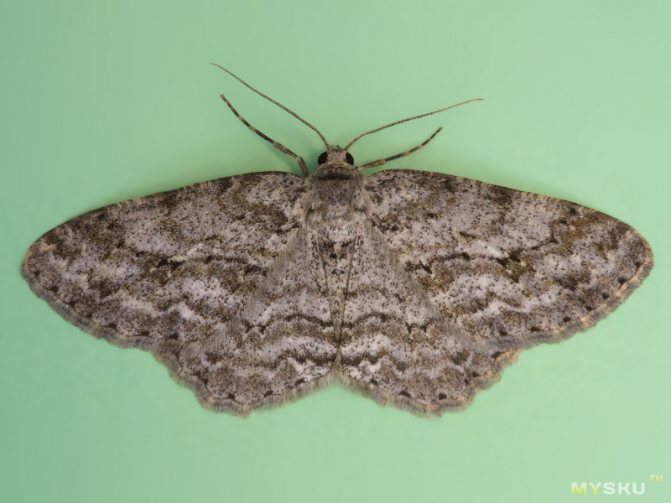

and quite pretentious:
Birch sickle
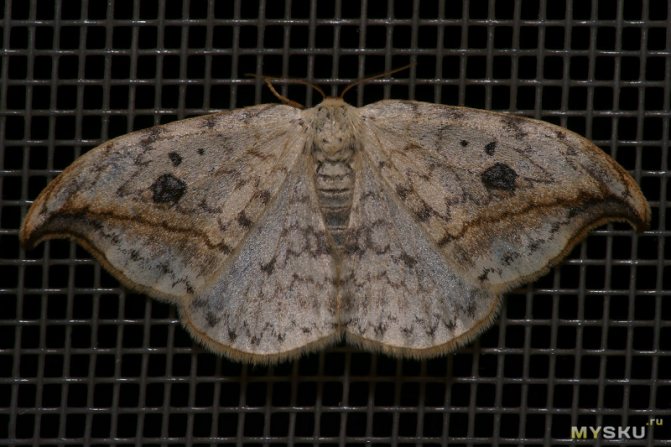

A rare evening went without all sorts of fires and moths, mostly not particularly photogenic.


However, this was not what I dreamed about, and it was not for this that I spent four thousand rubles that were not at all superfluous, to contemplate the nondescript gray-brown butterflies. The situation was reversed only on June 26, when a previously unseen butterfly called the "green shuttle" (Pseudoips prasinana) flew to the light. Although this butterfly is rather small, it stands out against the background of many other night moths with its pure green color. Despite the excellent camouflage that this color provides, among butterflies, especially Russian ones, for some reason it is not very popular, but in the south of the Krasnoyarsk Territory, species with such a color can be counted on the fingers of one hand. However, the rare coloring moth did not manage to organize a worthy photo session, since only an inflorescence that had dried up last fall was at hand.
Shuttlewoman green


The nights began to lengthen little by little, and every evening I continued to burn electricity in the hope of attracting something interesting.And in less than a week, this "interesting" deign to be attracted. At about one in the morning, I was about to turn off the lamp and go to bed, but for the sake of order, I finally checked the mosquito net. And he found that among the gray and boring scoops, a fluffy red butterfly was sitting on it. The butterfly was neatly caught during the preparation of the set, placed in a cage, photographed and released. Despite the fact that I managed to go to bed only at 4:00 in the morning, the result was worth it:
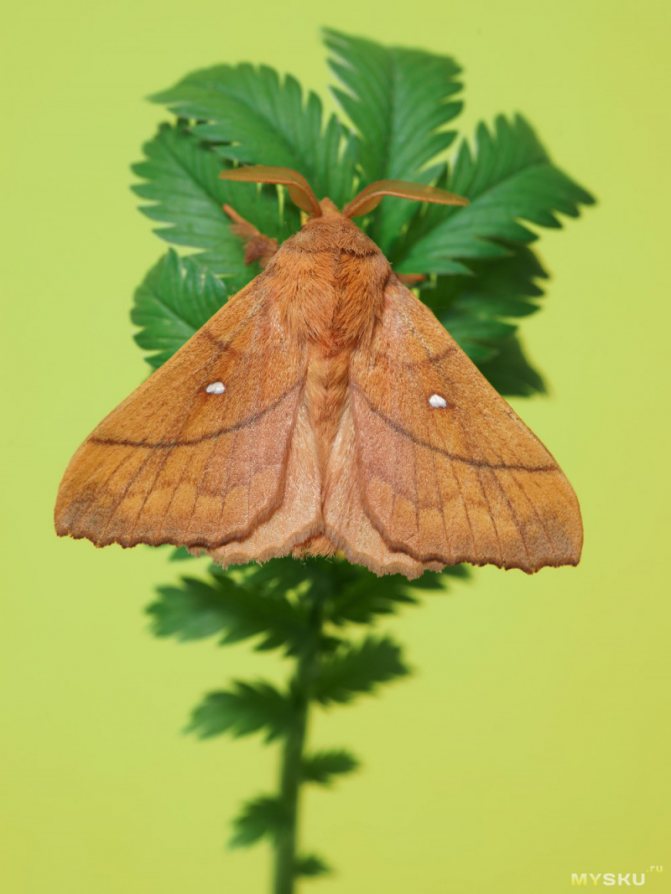

Later, the butterfly was identified as the "plum cocoon" (Odonestis pruni).
And at the very beginning of the third decade of July, the long-awaited large green moth finally arrived. Looking out in the first hour of the night, I saw that a white moth, noticeably larger than average, was beating into the net. Running it on the loggia, I discovered that the moth is not white at all, but the color, I would say, is malachite. Having hurriedly prepared the shooting range and seated the butterfly on a blade of grass, I started shooting. Unfortunately, I never managed to convince the butterfly to spread its wonderful wings to the end, but I did manage to do something:


Well, on the last day of July, I was settled by another wonderful butterfly with the mysterious name "metal drop".
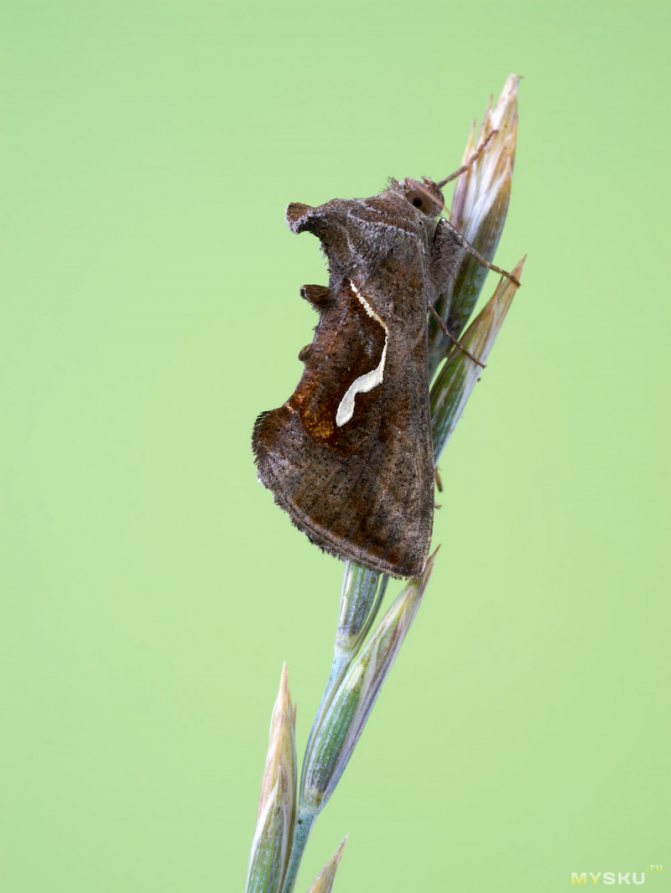

Since I lit the lantern almost every evening during the summer, little by little I have accumulated statistics that allow me to draw conclusions about its effectiveness in different conditions.
First of all, I found out that it makes no sense to turn on the flashlight in early twilight - the main flight in May-June and August began at 10 pm, and in July and even later, at about eleven. I usually extinguished the lantern at about one in the morning, after that time new insects almost never arrived on the net.
Worst of all, butterflies flew on rainy (obviously) and windy nights. Also, the lantern was almost useless on clear nights for several days before and after the full moon: no matter how good the weather was, if the full moon was shining in the sky, there was no need to wait for butterflies. And on moonless, but clear nights, Lepidoptera did not flock too willingly.
The flashlight gave the best results on cloudy, warm and calm nights of early July - then the mosquito net was covered with an almost continuous carpet of insects. Also, butterflies significantly increased in number when the weather changed from cool to warmer.
Summer this year began with us hot and sunny, but by July it slipped into a normal and moderately rainy one, which gave me the opportunity to observe the influence of temperature on the flight of moths. It turned out that the heat of night macro photography is not at all favorable. The butterflies flew well, but they behaved very actively, restlessly, and, instead of sitting quietly on the net while waiting for a photo session, they suddenly broke away and flew away into the darkness of the night about their business. And it was very difficult to work with those that remained: it took dozens of attempts and a lot of time to sit the butterfly on a blade of grass and shoot enough raw material from which in the future it would be possible to choose a couple of ideal shots.
As soon as the night temperature dropped to + 20 ° C, the butterflies became much more accommodating. But too good is also not good: when the night air cooled to + 15 ° C, interest in the lantern among insects greatly diminished. Inspecting the net, I found only a few scoopers on it, trying to keep warm, vibrating their wings with all their might. Well, after the thermometer dropped below + 10 ° C, the flashlight may not even be turned on, no one flew in anyway.
As a result, the lantern gave out the richest and most varied "catch" in June and July, the second half of May and the first of August were so-so, but in the last decade of August I, in fact, wasted electricity.
I also experimented with using a screen (which was a 1 meter white photographic reflector) placed behind the lantern and removing the protective glass (it was written on the store's website that this could increase the “attractiveness” of the lantern for insects). However, neither one nor the other had any noticeable positive effect.
But it turned out that not only moths, but also ordinary mosquitoes are attracted to the lantern. And if suddenly one of these scoundrels has leaked into your apartment, you should try to illuminate the wall with a flashlight monitored. After a while, the bloodsucker will most likely settle in a spot of ultraviolet light, where it can be safely exterminated.
When the summer came to its natural end, and the review came to its end, I examined the lantern. For three and a half months of not very intensive use (about three hours six days a week) one of the lamps darkened noticeably near the base. Which is obviously a sign of either a defective lamp or an improper power supply circuit, and in any case, a good reason to replace this lamp.


Which of the above are the conclusions regarding the reviewed product? Firstly, the entomological lantern really works and moths fly towards it. They do not fly as actively as we would like, and not all of the species that I wanted to get to know better, but here, I believe, is largely to blame for the unfortunate location of my loggia, where this lantern was used. Moreover, in addition to UV lamps, it would be nice to add a bright spotlight of the visible spectrum, for some insects this is for some reason important.
Secondly, this device is very specific, and is of interest mainly to amateur entomologists, macrophotographers and young naturalists, since it allows you to get acquainted with the world of nocturnal insects without leaving your own balcony or garden plot. However, a number of critical flaws for me, discovered during operation, do not allow me to definitely recommend it to everyone. Moreover, it is arranged so simply that, if desired, you can create your own, more efficient design with more powerful lamps and a capacious battery.
Advantages
- The lantern, as stated, attracts nocturnal insects in general and butterflies in particular.
- Relatively harmless to eyes and skin
- Suitable as an auxiliary tool for environmentally friendly mosquito control
- Can be assembled by yourself from finished parts
disadvantages
- The design includes a lead-acid battery
- Quite impressive dimensions
- High price
Insecticide traps
The insect trap, inside which there is a special insecticide, has also earned a lot of positive reviews. Cockroaches that have been inside the device and have tasted the poisonous bait, before they die, carry the poison on their paws to their nests and to places of large accumulation of congeners, which is why they are massively infected. The substance very quickly produces its destructive effect on the body of insects, poisoning and sterilizing them, and sometimes just a few days is enough to completely get rid of the numerous annoying rati, at the same time and greatly reduce their population as a whole.


Such traps can be used repeatedly, since insects can neither adapt nor get used to the poisonous substance from which the insecticide is produced. The back panel of most models of such traps is equipped with a sticky surface, which allows you to place the device even on vertical surfaces, for example, on the back wall of a kitchen cabinet or wardrobe, under a sink, on the side of a refrigerator.
A warning
However, in apartments and houses where there are small children, you should not use an electronic trap.Since, despite the fact that the current discharge is not fatal at all, but tangible, this can greatly scare a curious baby. According to the principle of operation and efficiency, the device has earned many positive reviews, the owner's task is only not to deviate from the instructions and prescriptions for the operation of the electronic trap and in the timely replacement of the lamp.
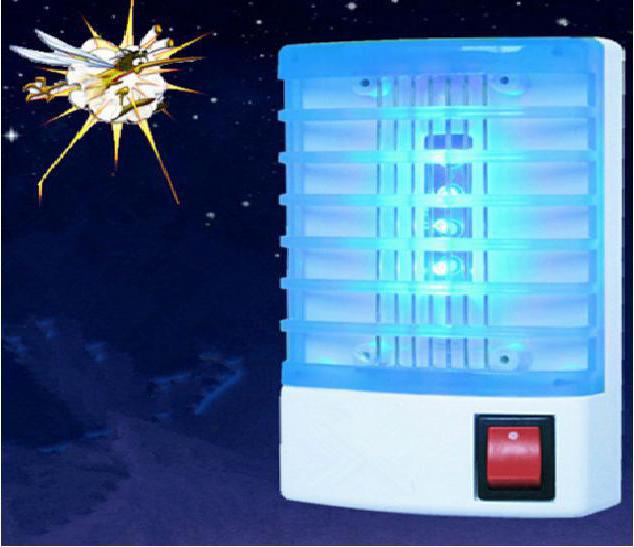

Homemade traps
A person often uses his ingenuity to achieve certain goals. The fight against insects was no exception. Pesky flies can irritate even the calmest person. For the destruction of insects, especially enterprising people make homemade traps.
Plastic bottle trap
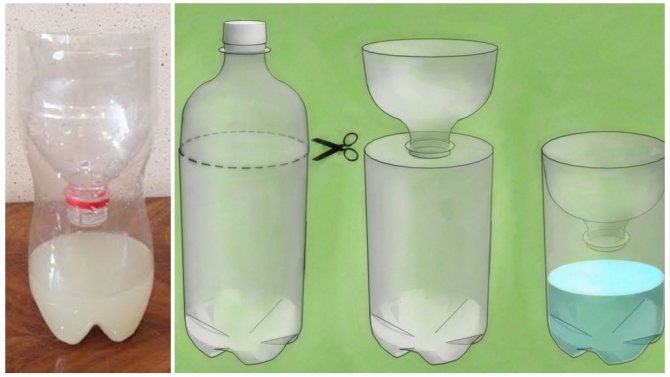

Plastic bottle trap
To make homemade products, you will need an ordinary plastic bottle with a volume of 1 or 1.5 liters, scissors or a knife, any sweet filling, scotch tape.
- The upper part is cut off from the bottle at a distance of 7-8 cm from the edge of the neck.
- At the bottom of the resulting container, bait is placed: jam, honey, syrup.
- The cut off funnel-shaped neck is pushed into the container with the neck down.
- The wide edge of the funnel and the upper edge of the container are fixed with tape or electrical tape.
On a note!
The narrow edge of the neck should not touch the sweet filling. Flies should not reach the sweetness without flying into the bottle.
Such a fly trap from a plastic bottle can catch other sweet-toothed insects: wasps, bees, midges. A simple and affordable way of making a trap allows you to throw it out with a large accumulation of insects inside and make a new one.
Glass flycatcher
You can make a fly trap from a regular glass or plastic cup and cling film. Put a teaspoon of honey or jam at the bottom of the glass. It is necessary to cover the glass with cling film and tighten it tightly, fixing the edges of the film with tape. Make 2-3 holes in the film so that the insect can penetrate into the glass. You can make several such homemade products and place them throughout the house.
Glass Jar Trap
In places where large flies congregate, you need a more serious bait - spoiled meat or fruits. They have a pungent strong odor and will attract more flying gnats.
- A liter glass jar with a wide neck is taken as a container.
- Several pieces of bait are put inside.
- A wide funnel is installed on top with a narrow neck down.
- The edges of the container and the wide edges of the funnel are fastened together with electrical tape or wide mounting tape for structural reliability.
On a note!
The strong smell of rotten vegetables, fruits or meat will be very unpleasant for the household and interesting for cats and dogs. Therefore, it is recommended to use such a flycatcher to catch flies on open verandas and place it in places inaccessible to animals.
Instead of a glass container, you can use a container made of dense plastic with a wide neck. The main condition for a reliable flycatcher is that there are no gaps between the funnel and the jar. Otherwise, flies can crawl out. Such traps are well suited for use in summer cottages, if placed around the perimeter of the site.
Duct tape


Fly Tape
One of the most popular fly traps is sticky tape. It is sold in any hardware store and costs from 20 to 50 rubles apiece. But if it is not possible to purchase a product in a store, you can do it at home. To do this, mix 1 tablespoon of rosin with a tablespoon of castor or linseed oil. Heat the resulting mixture in a water bath and stir for 5 minutes. Then add jam and cool. Apply the sticky mass to long strips of thick paper and hang in places where flies are often found.
If you follow the recipe, homemade glue remains sticky for a long time and is able to reliably hold insects attracted by the smell of jam on itself.
An effective trap for wasps and flies
There is a very effective device that has been tested by many site owners. To make it, you need a plastic bottle with a volume of 1.5 or 2 liters. The cover must be removed from it. The bottle must be cut into two pieces. In this case, the upper part should be half the size of the bottom. You will need to put a liquid bait inside. So that it does not spill, you need to place the upper part in the lower part with the neck inward. At this point, the trap can be considered ready.
Any sweet liquid can be used as bait. But it is best to take fermented compote, as it has a sharper smell. This completes the instructions on how to make a trap. Insects will fly to the smell and get inside, but they will not get out. Trying to crawl along the walls of the bottle, a wasp or a fly ends up in a dead end, which is formed due to the upper neck. It is better to make several such baits. They should also be reinforced in case of strong winds.
Most popular brands
Among the many different brands offering such traps in the insecticidal market and methods, the following companies are very effective products:
- Well (Russia, Inter-Med LLC;
- Chameleon (Russia);
- Ecosniper (Russia, Ukraine);
- Skat (Russia, Ukraine);
- Kill Pest (Russia, "Trading House Pallet Trucks") and other options.
Each insecticidal trap has its own price and depends on what range of exposure the device is designed for, whether there is a need to constantly buy consumables for them, whether they are easy to use and clean, and so on. All of them are powered by electricity, equipped with UV lamps of the appropriate range, so the use of industrial traps will always be associated with direct access to electricity.
Efficiency
Electronic catchers act not only on mosquitoes, midges, moths, butterflies, moths, and other insects fall into the trap. Some users see this as a disadvantage. The effectiveness depends on the quality of the device, power, range, correct application. It makes no sense to install powerful street traps indoors, the indoor insect-catcher night light will not work in the yard.


Electric Insect Traps
Electric traps are energy efficient. The cost is no more than an ordinary fluorescent light bulb. Many devices are powered by solar panels, rechargeable batteries.
How to get rid of mosquitoes
To control mosquitoes, you can make a regular sippy trap, but there is also a better remedy. It is worth trying to make an electromechanical device. To create it, you need a few materials at hand. The main component of the trap is an electric motor. Thanks to him, the trap has a suction effect. It pulls mosquitoes inside a special container from which they cannot get out.


How to make this type of mosquito trap? Everything is very simple. The power supply is based on a fan for the device can be an ordinary cooler, only, preferably, large. You can take a plastic bucket of mayonnaise as the basis of the case. In the bottom of the can, you need to make a hole equal in diameter to the dimensions of the cooler. The fan is usually sold complete with screws. They can screw the device to the bottom of the bucket. At the same time, the cooler is attached outside, not inside.
DIY trapping belt and trap for tree pests - all photos to the article
<автор владимир="">
TOOL FOR MASTERS AND MASTERS, AND HOUSEHOLD GOODS VERY CHEAP. FREE SHIPPING. RECOMMENDED - CHECKED 100% THERE ARE REVIEWS.
Below are other entries on the topic "How to do it yourself - a householder!"
- Do-it-yourself hunting belt A fishing belt for trees with your own ...
- The popular way of dealing with garden pests is a simple and effective We are fighting tree pests in ...
- DIY aerator How to make a lawn aerator ...
- How I make trapping belts for trees from pests DIY trapping belts - ...
- Do-it-yourself fishing belt made of foam rubber CATCHING BELTS FROM FOAM - ...
- DIY trap for a bear How to make a trap for a bear ...
- Do-it-yourself braided belt (+ diagram) How to weave a belt from a cord For ...
Subscribe to updates in our groups and share.
Let's be friends!
With your own hands ›Summer cottage garden and vegetable garden› DIY pest traps - photo

